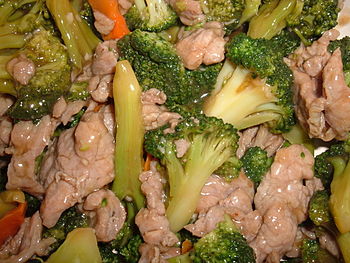 |
| lemon Chicken - Poto: Pxhere |
Chinese cooking can be very healthy as it contains low carb as well as low-fat dishes. Today, I am sharing with you two low carb Chinese recipes for Chinese green beans and Chinese lemon chicken, a classic in Chinese cooking.
Low Carb Recipe of Chinese Green Beans
Ingredients:
1 pkg frozen green beans -- (16 ounces) 500g
1 pkg chicken broth -- dry crystals
1 bunch scallion
2 lg garlic bulb
1/2 tsp ground ginger
1 tsp Splenda
1 tbsp peanut butter -- creamy
1/8 tsp sesame oil -- Chinese
Directions:
In a 2-quart 2 liter microwave-safe casserole dish, combine green beans and broth granules. Cover and microwave on high for 4 minutes. Meanwhile, slice white bulbs of scallion into rings and mine garlic. In a small bowl, combine ginger, soy sauce, and SPLENDA. Add scallion rings and garlic. Set aside. Remove green beans from microwave and uncover. Pour sauce over beans and stir. Cover and microwave on high for 4 minutes. Stir in peanut butter and sesame oil until sauce coats the beans and serves immediately. Make 6 servings
Nutritional information, per serving (excluding unknown items):
52 Calories; 2g Fat (29.4% calories from fat); 3g Protein; 7g Carbohydrate; 1g Dietary Fiber; 0mg Cholesterol; 143mg Sodium. Exchanges: 0 Grain (Starch); 0 Lean Meat; 1 Vegetable; 0 Fat.
Low Carb Recipe of Lemon Chicken
Ingredients:
2 tablespoons Dry sherry
4 green (Spring) onions, chopped
1 Piece of root ginger, shredded
500g (1 pound) boned chicken, cut into 1 inch strips
2 Celery sticks, sliced
125g (4oz) button mushrooms, quartered
1 Green pepper, cored, seeded, and sliced
2 tablespoons Light soy sauce
Shredded rind of 2 lemons
A few lemon slices to garnish
2 tablespoons oil for stir-frying
Directions:
Put the sherry, spring onions and ginger in a bowl. Add the chicken, toss well to coat, then leave to marinate in the bowl for 15 minutes.
Heat the oil in a wok or frying pan. Add the celery, mushrooms, and the green pepper and stir-fry for one minute. Add the chicken and marinade, then cook for 3 minutes. Stir in the soy sauce and lemon rind then cook for a further minute.
To serve, pile into a warmed serving dish and garnish with lemon slices. Makes 4 to 6 servings. Preparation Time: 45 minutes
Nutritional information, per serving
294 Calories; 6g Fat (20.0% calories from fat); 53g Protein; 3g Carbohydrate; trace Dietary Fiber; 144mg Cholesterol; 346mg Sodium. Exchanges: 0 Grain (Starch); 7 1/2 Lean Meat; 0 Vegetable; 0 Fruit; 0 Fat.






